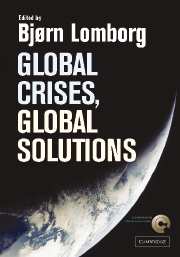Book contents
- Frontmatter
- Contents
- List of figures
- List of tables
- List of boxes
- List of contributors
- Acknowledgements
- List of abbreviations and acronyms
- Introduction
- PART I THE CHALLENGES
- 1 Climate change
- 2 Communicable diseases
- 3 Conflicts
- 4 Access to education
- 5 Financial instability
- 6 Governance and corruption
- 7 Malnutrition and hunger
- 8 Migration
- 9 Sanitation and access to clean water
- 10 Subsidies and trade barriers
- PART II RANKING THE OPPORTUNITIES
7 - Malnutrition and hunger
Published online by Cambridge University Press: 22 September 2009
- Frontmatter
- Contents
- List of figures
- List of tables
- List of boxes
- List of contributors
- Acknowledgements
- List of abbreviations and acronyms
- Introduction
- PART I THE CHALLENGES
- 1 Climate change
- 2 Communicable diseases
- 3 Conflicts
- 4 Access to education
- 5 Financial instability
- 6 Governance and corruption
- 7 Malnutrition and hunger
- 8 Migration
- 9 Sanitation and access to clean water
- 10 Subsidies and trade barriers
- PART II RANKING THE OPPORTUNITIES
Summary
Introduction: The Challenge of Malnutrition and Hunger
While episodes of severe hunger such as famines receive considerable press coverage and attract much public attention, chronic hunger and malnutrition is considerably more prevalent in developing countries. It is estimated that at least 12 m low-birth-weight (LBW) births occur per year and that around 162 million pre-school children and almost a billion people of all ages are malnourished. In poorly nourished populations, reductions in hunger and improved nutrition convey considerable productivity gains as well as saving resources that would otherwise be used for the care of malnourished people who are more susceptible to infectious diseases and premature mortality. While reducing hunger and malnutrition is often justified on intrinsic grounds, it is these potential gains in productivity and reductions in economic costs that provide the focus of our challenge paper.
Poverty, hunger and malnutrition are linked. Strauss and Thomas (1995, 1998) and Hoddinott, Skoufias and Washburn (2000) document the empirical literature relating dimensions of access and intakes of calories to household consumption levels. A reasonable reading of these studies suggests an income–calorie elasticity of around 0.2–0.3, though careful studies have also found estimates both higher and lower than this range. Behrman and Rosenzweig (2004) report that cross-country variation in GDP per worker in PPP terms is inversely related to the percentage of LBW (< 2.5 kg) births among all births and is consistent with almost half of the variation in the percentage of births that are LBW across countries.
- Type
- Chapter
- Information
- Global Crises, Global Solutions , pp. 363 - 442Publisher: Cambridge University PressPrint publication year: 2004
- 65
- Cited by

